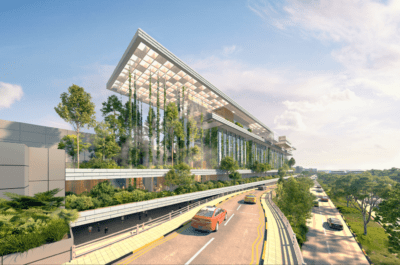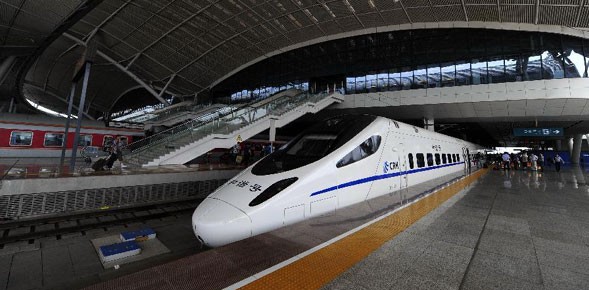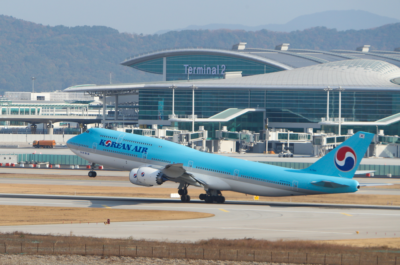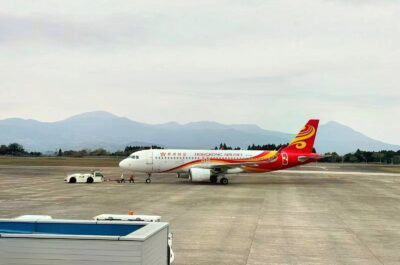Crowded rail lines all over China’s train network will partially alleviated by separating passengers and freight rail network. China expects to improve the situation by 2015 when most of its high-speed passengers’ train network will be completed.
BEIJING- According to a five-year plan on China’s transport system recently approved by the State Council, China’s cabinet, China will create a high-speed railway backbone network featuring four east-west lines and four north-south lines by the end of 2015.The Ministry of Railways told Xinhua that the total length of high-speed railways will reach some 18,000 km by then.
China’s high-speed lines, which should have an average speed of over 200 km per hour, had a length of 6,894 km in August, down from last year as a speed cut was implemented following the deadly Wenzhou accident, according to the ministry.
Railway expert Wang Mengshu said that as new high-speed lines open, transportation capacity will be released from conventional lines, which will gradually turn into freight lines.”Putting passenger and freight on separate tracks will greatly increase traffic volume,” said Wang, also an academician of the Chinese Academy of Engineering. “The plan indicates that China will continue to develop high-speed trains to address its transportation bottleneck.”
Wenzhou collision last July that left 40 dead seriously dented China’s enthusiasm for high-speed rail. China halted work on new lines and conducted nationwide safety checks. A total of 54 people, including minister-level officials, were punished following the accident. Local railway bureaus and stations have been ordered to improve train scheduling and management, as well as conduct more intensive work safety training. A railway ministry report released in July says that signalisation and lightning diffusion equipment have been checked and reinforced at more than 1,000 railway stations.The changes were in response to the two major causes of the Wenzhou accident, management failure and faulty signaling equipment.
“With technical solutions and disciplined operation, China’s high-speed railways will be safer,” said Huang Qiang, chief researcher at the China Academy of Railway Sciences. Wang said China should always bear the accident in mind and learn from past mistakes. “This will be highly important in China’s further pursuit of technological innovation and advancement.”
Wang held that China should persist in the high-speed railway development. “Over the past 15 years, China has raised the speed of its conventional lines six times, leaving little room for further improvements. It will be very dangerous if we continue to raise the speed of conventional lines. Therefore, we must build new dedicated passenger lines,” he said.
Passenger trains have shared the same tracks as freight trains since the creation of China’s rail system. The shared railroad system has made it difficult to meet market demand on busy lines. World Bank figures show that China has by traffic volume the world’s second business freight railway and the busiest passenger railway.
Wang noted that China had only 93,000 km of railways by the end of 2011. “The railway density in China is far from adequate to serve the world’s second-largest economy,” he said.
Ye Tan, a well-established economic commentator in China, said the creation of a high-speed network will leave more conventional lines free to carry cargo and meet market demand.
Passengers are returning to China’s high-speed rails. Some 52.6 million passengers traveled on the Beijing-Shanghai high-speed railway in its first year of operation, which ended on June 30. More than 144,000 passengers on average travel on the line daily. While more major Chinese cities are getting connected with high-speed lines, a larger network is under plan to link all cities with a population of at least 500,000 inhabitants. The rail ministry is now looking at inviting private investors to participate in the funding of these ambitious rail projects.
Tomorrow, a new high-speed railway connecting Hefei and Bengbu, two cities of east China’s Anhui Province, will be put into operation on Oct. 16. The new rail line covers a distance of 132 kilometers and trains will run on it at a designed speed of 350 km per hour.
Luc Citrinot a French national is a freelance journalist and consultant in tourism and air transport with over 20 years experience. Based in Paris and Bangkok, he works for various travel and air transport trade publications in Europe and Asia.

































![[PR] PR_Ascott and Vimut Hospital_2024](https://www.traveldailynews.asia/wp-content/uploads/2024/04/PR-PR_Ascott-and-Vimut-Hospital_2024-400x265.jpg)









































